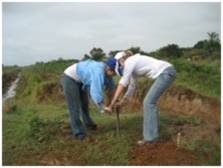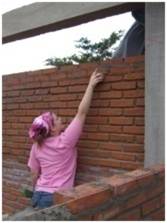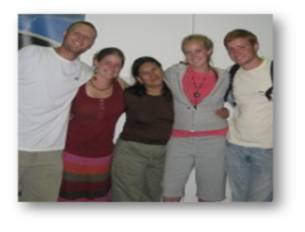2008
Projects: |
|
Canal Magisterio
Charles Hoppesch - Andrea Smeltzer - Matthew Tronnes - Pamela Wolting
Video of Powerpoint Slide Show (Flash) TEST VERSION
Click to enlarge some images

|
Background
During July of 2008 the International Senior Design (ISD) program of Michigan Technological University (MTU) traveled to Santa Cruz, Bolivia. Arial Engineering is comprised of four undergraduate civil engineering students including: Charles Hoppesch, Andrea Smeltzer, Matthew Tronnes, and Pamela Wolting
|
|
Figure 1: Photographs of AE, Concrete Lined Canal, & Canal Magisterio Site
|

|
Project Scope
Arial Engineering (AE) was asked by Ing. Victor Escobar, Subalcalde of District 12 in Santa Cruz, to design a concrete lined canal that will be placed between a two lane road. AE spent two weeks in Santa Cruz surveying the site, interviewing local residents, and meeting with government officials and engineers.
The residents of the Canal Magisterio area of District 12 are experiencing flooding of homes and roadways waist deep for most of the November – March rainy season. Flooding in this area is increased due to contributions of storm water from the adjacent District 9. The city of Santa Cruz central storm water drainage office has prioritized Canal Magisterio as a needed primary storm drainage canal. The proposed Canal Magisterio will alleviate flooding by transporting the flood waters to an existing stream, El Terrible, which must also be enlarged.
|
| |
Design Options
Three design options were considered for Canal Magisterio. Each has their own advantages and disadvantages and will be implemented in the appropriate locations.
- Concrete Box/Pipe -
Advantages: Safe, Space Efficient
Disadvantages: Expensive, Clogging Inlets, High Maintenance
- Earthen Canal -
Advantages: Low Cost, Short Construction Time
Disadvantages: Erosion, High Maintenance, Vegetation Overgrowth
- Concrete Ideal Trapezoid -
Advantages: Constructability, Optimal Flow, Minimal Material Use
Disadvantages: Safety Issues, Sanitation |

Figure 2a,b,c: Box Culvert, Earthen Canal, & Concrete Lined, Ideal Trapezoidal Canal


|
Recommendation
The final design should allow the canal and roadway to function in high intensity storms during the rainy season, sedimentation buildup, and erosion concerns while providing a construable, cost effective project with minimal maintenance.
A box culvert that is designed by others will transport storm water under the railroad tracks (orange), entering an open, concrete lined, ideal trapezoidal canal, approximately 3.7 Kilometers in length (placed along red and yellow). Where AE survey data ends, the concrete canal will transition to a temporary earth canal (green). In addition, El Terrible (blue) should be studied and sized accordingly.
|





|
Impact on Community
Reducing standing flood water in the Canal Magisterio watershed has the following social, environmental, economic, and construction impacts on the community of District 12:
Thinning breeding ground for mosquitoes, thus reducing mosquito borne diseases such as dengue fever and malaria
Reduces possibility of storm water mixing with poorly or untreated wastewater since storm water will flow into the canal rather than continue to stand as floodwater around residential homes.
Decreases health risks to humans and animals that come in contact with contaminated flood water and water borne pathogens due to previous bullets.
Increase the ability of residents to attend work or school as roadways will be open for safe travel.




|
|
|
|
|
Last Modified on : November 1, 2013
Michigan
Technological University
1400 Townsend Drive
Houghton, Michigan, 49931 - 1295, USA
Department Phone: 1-906-487-2520
Department Fax: 1-906-487-2943
Department E-mail
Michigan Technological University
is an equal opportunity educational institution / equal opportunity employer
|
For more info contact:
David Watkins
806 Dow Environmental Sciences and Engineering Building
(906) 487-1640
email: |
|

